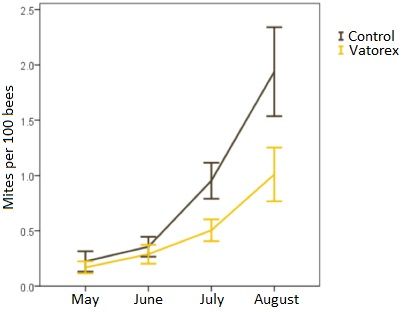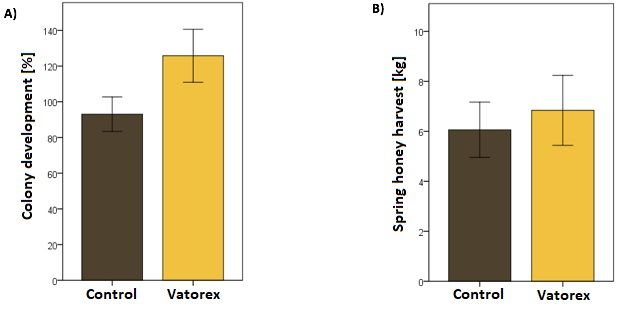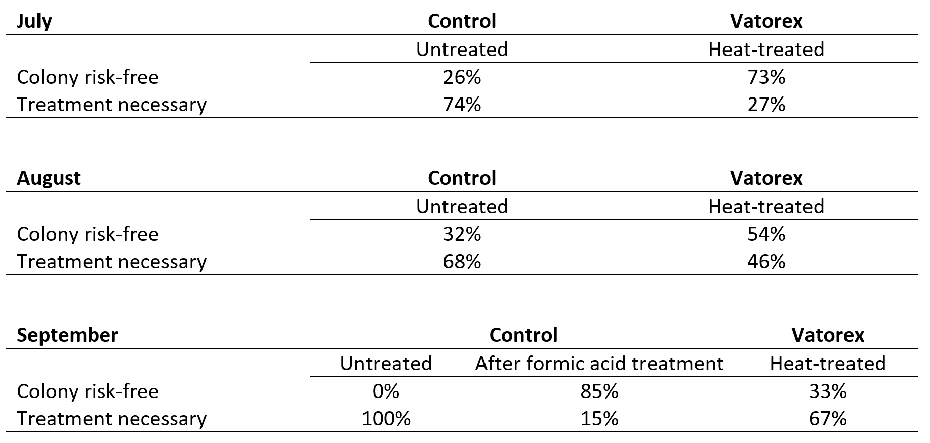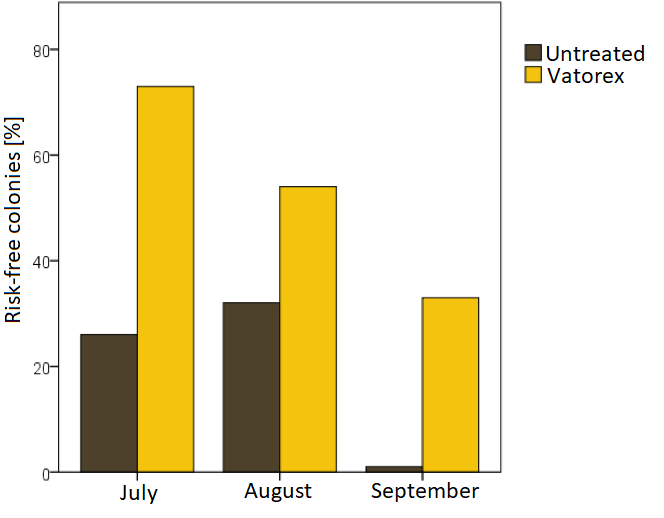Short summary
In 2017, the effectiveness of the Vatorex system was investigated with a total of 64 colonies. The most important points are summarized here below, more details can be found in the rest of the article. You will also find the outlook for the new 3th generation Vatorex-System in this report.
95% Varroa-offspring killed per treatment
50% Varroa reduction in the colony
31% Improved population development
1kg more honey per colony
33% of the colonies in September were free of risks
Scientific results
Results of varroa mites counts
In order to estimate the effect of a single heat treatment, heatable brood combs were placed at the end of the bee season (August to October) in bee colonies with high varroa infestation. As soon as the combs had covered brood, they were treated once for three hours. Subsequently, individual cells were opened within 24 to 72 hours after treatment and the larvae and varroa mites inside were analysed.
While no unusual damage (2 – 3.6% dead larvae) occurred in the bee brood, 95% of the Varroa offspring were killed. This was particularly evident for the males mites, which crawled out of the cells in untreated control honeycombs, but were found motionless on the cell floor after heat treatment.
Results of the field data
In the 2017 field trial, the effectiveness of the Vatorex system on the development of varroa in the colony was tested. A total of 64 colonies at 5 apiaries were tested, half of the colonies at each location were equipped with the Vatorex system and the other half functioned as control colonies. In the period from May to August, the mite infestation of the peoples was measured every four weeks with the powder sugar method. After two months of treatment with the Vatorex system (in July), the mite infestation was significantly reduced by 47% (P = 0.002), after three months (in August) by 48% (P = 0.009) (Figure 1). In addition, the strength of the colonies was measured before the start of treatment and at the end of July. The populations equipped with the Vatorex system showed a significantly improved population development compared to the control populations (P = 0.016) (Figure 2). Thus, on average 16% more spring honey (P = 0.67) could be harvested from the Vatorex colonies (Figure 3). These results show a significantly improved health of the bee colonies in the period before the Varroa summer treatment.


At the end of August, half of the control populations was treated once with formic acid (60% ad. us. vet.). From the end of July to the end of September, the mite infestation of all colonies was classified according to the guidelines1 of the Swiss bee health service apiservice in «harmless» and «treatment» necessary. The Vatorex system was able to keep a third of the colonies in the safe range until the end of September – formic acid treatment was no longer necessary for these colonies. In the other colonies, it was possible to slow down the reproduction of the mites, but the reduction was not sufficient to do without further treatment (Table 1, Figure 3). Therefore it is still the responsibility of the beekeeper to control the mite infestation of his colonies and to treat them if necessary. The Vatorex system reduces varroa infestation by almost 50%, which drastically reduces the use of acids and improves the health and population development of honeybee colonies.


Outlook 2018
Precise treatment
Since the new Vatorex system has a controller on each honeycomb, the temperature can be controlled much more accurately. Resistance fluctuations in the supply line or contact problems, which partially affected the 2nd generation, are now a thing of the past. Another great advantage is the temperature memory of the heating wire, which is now available through a unique ID of the comb module. So, even combs that are only have brood present on a part of the comb are treated correctly.
Improved beekeeping practice
Generation 3 is completely cable-free in bee colonies. A heating honeycomb no longer differs from a normal brood honeycomb, the power is supplied to the honeycomb module via the frame rails and stainless-steel connections on the honeycomb frame. In addition, the system works absolutely independently and fully automatically, without any beekeeping intervention.
Status updates via app
The current treatment status can be viewed via a mobile app. This simplifies the control and the work with the colony. Other important characteristics of the colony (e.g. honey yield, colony strength, reminders) can also be recorded and are available at any time. With statistics and analysis the beekeeper always keeps full control over the condition of the bee colonies.
Literature
https://www.bienen.ch/fileadmin/user_upload_relaunch/Dokumente/Bienengesundheit/Varroa/1.5.2_puderzuckermethode.pdf